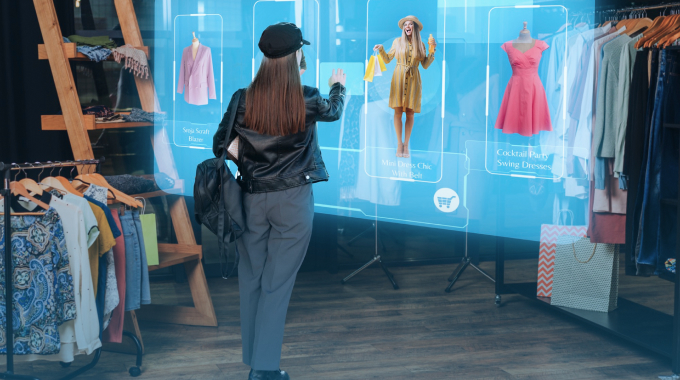
- July 25, 2024
- Abi Therala
- 0
Generative AI: Revolutionizing Retail E-commerce
Generative AI has transformed the way businesses are run. Tools like ChatGPT and Midjourney are helping businesses usher in a new era of innovation in the e-commerce landscape. It’s more than just creating chatbots or artwork; it’s a dynamic force transforming the way retailers operate, engage customers, and ultimately, drive sales.
The Virtual Shopping Assistant: Personalized Guidance at Scale
One of the most impactful applications of generative AI in e-commerce is the creation of virtual shopping assistants. These AI-powered tools act as knowledgeable guides, helping customers navigate the vast world of online shopping.

How it works:
- Customer Profiling: Leveraging browsing history, purchase data, and even social media interactions, generative AI builds a detailed profile of each customer’s preferences and style.
- Personalized Recommendations: The AI assistant then curates a selection of products tailored to each individual’s tastes. This goes beyond simple “customers who bought this also bought that” algorithms; the AI understands nuances in style, fit, and even the occasion for which the customer is shopping.
- Natural Language Interaction: Customers can communicate with the assistant using natural language, asking questions like, “What dress would be best for a beach wedding?” or “Can you find me jeans similar to these but in a darker wash?”
Benefits:
- Increased Sales: Personalized recommendations lead to higher conversion rates.
- Enhanced Customer Experience: Shopping becomes more enjoyable and efficient.
- Reduced Returns: Customers are more likely to be satisfied with their purchases.
Additional Considerations:
- Voice-Activated Assistants: Integrating voice technology can make the shopping experience even more seamless and intuitive.
- Multi-Channel Integration: Virtual assistants can be deployed across various platforms, including websites, mobile apps, and social media, providing consistent guidance wherever the customer interacts with the brand.
- Continuous Learning: The AI assistant learns and improves over time, becoming even more adept at understanding and anticipating customer needs.
Virtual Try-Ons: Bridging the Online-Offline Gap
One of the biggest hurdles in online shopping is the inability to physically try on products. Generative AI is changing that with virtual try-on experiences.

How it works:
- 3D Modeling: AI algorithms create detailed 3D models of clothing and accessories.
- Augmented Reality: Using a smartphone or webcam, customers can overlay these 3D models onto their own image or video.
- Realistic Simulation: The AI adjusts the fit of the garment to the customer’s body shape, even simulating how different fabrics would drape or move.
Benefits:
- Increased Confidence in Purchases: Customers can see how products look on them before buying.
- Reduced Returns: Fewer items are returned due to fit or style issues.
- Increased Engagement: Virtual try-ons make shopping more interactive and fun.
Additional Considerations:
- Customization: Virtual try-ons can go beyond clothing and accessories. Customers can virtually try on makeup, hairstyles, and even furniture in their homes.
- Social Sharing: Integrating social media sharing allows customers to get opinions from friends and family before making a purchase.
- Data Collection: Virtual try-ons can provide valuable data on customer preferences and fit issues, helping retailers refine their product offerings.
Content Customization: The Power of Personalization
Generative AI enables retailers to create personalized content at scale, tailoring product descriptions, marketing emails, and even social media posts to individual customers.
How it works:
- Dynamic Content Generation: AI algorithms can generate unique product descriptions based on a customer’s profile. For example, a description for a hiking boot might emphasize lightweight materials for a customer who values comfort, while highlighting durability for someone who prioritizes longevity.
- Targeted Marketing Campaigns: Marketing emails can be personalized with product recommendations, special offers, or content relevant to the customer’s interests.
- Interactive Social Media: Generative AI can create social media posts that invite customers to engage, such as polls asking for opinions on new styles or quizzes to help them find the perfect product.
Benefits:
- Higher Conversion Rates: Personalized content resonates more with customers, leading to increased sales.
- Improved Customer Engagement: Customers are more likely to interact with content that feels relevant to them.
- Stronger Brand Loyalty: Personalized experiences foster a sense of connection between the customer and the brand.
Additional Considerations:
- Privacy and Data Ethics: Retailers must be transparent about how they collect and use customer data to personalize content.
- Avoiding Over-Personalization: Too much personalization can feel invasive or creepy. Retailers need to find the right balance.
- Content Quality: While AI can generate content quickly, it’s important to ensure that the content is high quality and engaging.
Enhanced Product Search: Finding Exactly What You Want
Generative AI is making product searches more intuitive and accurate.
How it works:
- Natural Language Processing: Customers can search using everyday language, such as “comfortable shoes for walking” or “red dress for a party.”
- Image and Visual Search: Customers can upload photos of items they like or use visual search tools to find similar products.
- AI-Powered Filtering: AI algorithms can filter search results based on a customer’s preferences and past purchases.
Benefits:
- Improved User Experience: Customers can find what they’re looking for quickly and easily.
- Increased Sales: Customers are more likely to buy when they can find the right product.
- Reduced Frustration: Customers are less likely to abandon their search if they get relevant results.
Streamlining Operations: Behind the Scenes Efficiency
Generative AI isn’t just about customer-facing applications; it’s also transforming the way retailers operate.
How it works:
- Inventory Management: AI can forecast demand, optimize stock levels, and automate replenishment.
- Customer Service: AI-powered chatbots can handle routine inquiries, freeing up human agents to focus on complex issues.
- Fraud Detection: AI algorithms can analyze patterns in transaction data to identify and prevent fraudulent activity.
Benefits:
- Cost Savings: Automation reduces labor costs and minimizes errors.
- Improved Efficiency: Operations run more smoothly, leading to faster delivery times and better customer service.
- Increased Security: AI can help protect retailers and customers from fraud.
Additional Considerations:
- Human Oversight: While AI can automate many tasks, it’s important to have human oversight to ensure quality control and address complex issues.
- Data Security: Retailers must take steps to protect sensitive customer data from unauthorized access.
- Ethical Considerations: AI should be used in a way that is fair and unbiased.
The Economic Impact of Generative AI in E-commerce
Generative AI isn’t just a technological marvel; it’s an economic force. By automating tasks, personalizing experiences, and driving sales, it’s reshaping the financial landscape of the e-commerce industry.
- Increased Revenue: Through personalized recommendations, targeted marketing, and enhanced product search, generative AI can significantly boost sales and revenue for e-commerce businesses.
- Cost Reduction: By automating customer service, inventory management, and other operational tasks, AI can reduce labor costs and improve efficiency.
- Market Expansion: Generative AI can help retailers reach new markets by creating personalized content and experiences that resonate with diverse audiences.
The Ethical Implications of Generative AI
As with any powerful technology, generative AI comes with ethical considerations that retailers must navigate responsibly.
- Data Privacy: Ensuring the secure and ethical handling of customer data is paramount. Retailers must be transparent about how they collect and use data, obtain proper consent, and protect sensitive information from unauthorized access.
- Bias and Discrimination: AI algorithms can inadvertently perpetuate biases present in the data they are trained on. Retailers must take proactive steps to identify and mitigate biases in AI-generated content and recommendations.
- Transparency: It’s important for retailers to be transparent about how they use AI, clearly communicating to customers when they are interacting with an AI system and how their data is being used.
Case Studies: Real-World Applications of Generative AI
To truly understand the impact of generative AI, let’s look at some real-world examples of how retailers are leveraging this technology.
- Stitch Fix: This online personal styling service uses AI to curate personalized clothing recommendations for each customer based on their style profile and feedback.
- Sephora: Sephora’s Virtual Artist tool uses AI to allow customers to virtually try on makeup products and get personalized recommendations.
- Amazon: Amazon employs AI to power its product recommendations, search algorithms, and even its warehouse robots.
- Levi’s: Levi’s has partnered with Lalaland.ai to generate models of diverse body types and skin tones to showcase their clothing, promoting inclusivity and helping customers visualize how clothes will look on them.
- Nike: Nike’s “Nike By You” platform allows customers to customize their shoes, using AI to generate previews of their designs.
- Alibaba: This Chinese e-commerce giant uses AI to generate product descriptions, optimize pricing, and even design store layouts.
The Future Landscape of E-commerce with Generative AI
The future of e-commerce is undeniably intertwined with generative AI. As the technology continues to evolve, we can expect even more innovative applications that will reshape the way we shop.
- Hyper-Realistic Virtual Stores: AI-powered virtual stores could become so immersive that they rival the experience of shopping in a physical store, allowing customers to browse virtual aisles, interact with products in 3D, and even try them on virtually.
- AI-Driven Design and Manufacturing: GenAI tools could be used to create unique, personalized products on demand, revolutionizing the concept of mass customization. Imagine a world where you can design your own pair of shoes, a dress that fits you perfectly, or even a piece of furniture tailored to your living space, all with the help of AI.
- Emotional AI: AI could evolve to understand and respond to human emotions more effectively, creating even deeper connections between retailers and customers. This could manifest in virtual shopping assistants that not only offer product recommendations but also empathetic support, or chatbots that can detect and respond to a customer’s frustration or excitement.
- Supply Chain Optimization: Generative AI could further streamline logistics and inventory management, predicting demand with even greater accuracy, optimizing delivery routes, and minimizing waste. This would not only reduce costs for retailers but also contribute to a more sustainable e-commerce ecosystem.
- Enhanced Customer Service: AI-powered chatbots could become even more sophisticated, capable of handling complex inquiries, resolving issues in real time, and providing personalized support that goes beyond simple FAQs. This could lead to higher customer satisfaction and loyalty.
- New Business Models: Generative AI could even give rise to entirely new business models in e-commerce. For example, AI could be used to create virtual marketplaces where customers can interact with brands and products in innovative ways, or platforms that facilitate peer-to-peer commerce driven by AI-powered recommendations and reviews.
- Dynamic Pricing: AI can analyze market trends, competitor pricing, and customer behaviour to dynamically adjust prices, maximizing profitability for retailers while ensuring fair pricing for consumers.
- Image Enhancement: AI can automatically enhance product images, making them more visually appealing and increasing the likelihood of a purchase.
The potential of generative AI in e-commerce is vast and exciting. By embracing this technology responsibly and creatively, retailers can unlock new levels of growth, efficiency, and customer satisfaction.
The potential of generative AI in e-commerce is vast and exciting. By embracing this technology responsibly and creatively, retailers can unlock new levels of growth, efficiency, and customer satisfaction.
Conclusion
The integration of generative AI in e-commerce is not just a trend; it’s a paradigm shift. By transforming the way retailers operate and engage with customers, generative AI is paving the way for a future where online shopping is more personalized, immersive, and efficient than ever before. As this technology continues to advance, we can expect even more groundbreaking innovations that will redefine the e-commerce landscape. It’s an exciting time to be a part of this industry, and retailers who embrace this change will be well-positioned for success in the years to come.
By understanding and leveraging the power of generative AI, e-commerce businesses can not only meet the evolving needs of their customers but also stay ahead of the curve in an increasingly competitive market. The journey has just begun, and the possibilities are endless.


